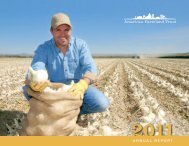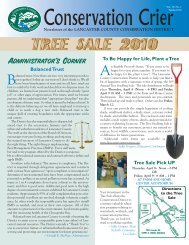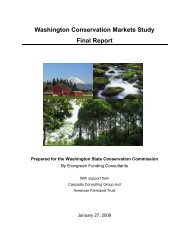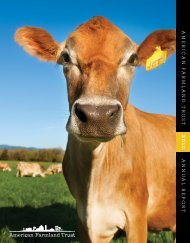Farms for the Future: Massachusetts - American Farmland Trust
Farms for the Future: Massachusetts - American Farmland Trust
Farms for the Future: Massachusetts - American Farmland Trust
You also want an ePaper? Increase the reach of your titles
YUMPU automatically turns print PDFs into web optimized ePapers that Google loves.
<strong>Farms</strong> <strong>for</strong> <strong>the</strong> <strong>Future</strong>program, <strong>the</strong> FVEP program, and <strong>the</strong> state’s AEEPare given priority as each of <strong>the</strong>se programsrequires that farmers have and comply with afarm conservation plan. The Commonwealth’sannual investment of around $200,000 has beenmatched with equal funding from USDA’s NaturalResources Conservation Service (NRCS). 36FARM-TO-SCHOOLInterest in serving locally grown foods in schoolcafeterias and o<strong>the</strong>r public and private institutionshas increased dramatically in recent years, and arecently enacted state “agricultural preference”law is intended to encourage this trend.Through support <strong>for</strong> <strong>the</strong> Farm-to-School Project,<strong>the</strong> MDAR helps match farm suppliers with institutions.In <strong>the</strong> past three years, <strong>the</strong> number offarms selling directly to schools has grown from20 to 69. State spending on this initiative totaled$65,000 in 2005 and 2006. The program’s totalbudget <strong>for</strong> 2008–2009 is $133,000. 37Over 167 public school districts,private schools and colleges around <strong>the</strong> statenow serve local foods.AGRICULTURE BUSINESS TRAINING PROGRAMThe Agricultural Business Training Program(ABTP) provides locally tailored business trainingto farmers around <strong>the</strong> state. The program offersmultiple course <strong>for</strong>mats, including a 10-sessiongeneral agriculture business course (Tilling <strong>the</strong>Soil of Opportunity) and beginning farmertraining (Exploring Your Small Farm Dream).Co-sponsors of <strong>the</strong>se courses have includedregional “Buy Local” campaigns, ResourceConservation and Development Councils,Community Development Corporations, andcommodity associations.Since <strong>the</strong> program began, more than 300 farmbusinesses have graduated from <strong>the</strong> program’svarious courses. From 2001 to 2005, <strong>the</strong> programspent approximately $15,000 per year, some ofwhich came from federal grants. In 2006 and2007, program spending increased to $30,000with new course <strong>for</strong>mats. The MDAR anticipatesthat <strong>the</strong> program will cost $35,000 annually infuture years. 38Improving on-farm irrigation efficiencyrelieves pressure on public water supplies andimproves stream flows <strong>for</strong> fish and o<strong>the</strong>raquatic species.AGRICULTURAL ENVIRONMENTALENHANCEMENT PROGRAMThe AEEP is designed to help farms mitigate <strong>the</strong>irimpact on <strong>the</strong> environment and to encourage environmentalstewardship. While primarily a waterquality program, AEEP also funds practices thatpromote energy efficiency, conserve water and$2.5Farm Viability Enhancement Program:Historic Spending$2.1Million MIllions$2.0$1.5$1.0$1.3$0.8$1.7$1.5$1.0 $1.0$1.5$1.2$1.1$1.2$0.5$0.0FY98 FY99 FY00 FY01 FY02 FY03 FY04 FY05 FY06 FY07 FY08NOTE: Adjusted <strong>for</strong> Inflation: based upon <strong>the</strong> Bureau of Labor and Statistics CPI calculator: http://data.bls.gov/cgi-bin/cpicalc.plSource: <strong>Massachusetts</strong> Department of Agricultural Resources, 200814<strong>American</strong> <strong>Farmland</strong> <strong>Trust</strong>



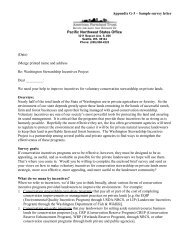

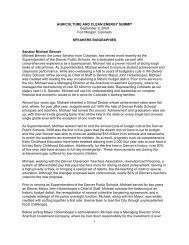
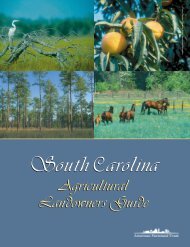
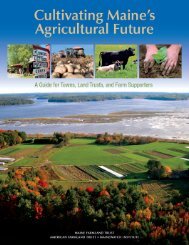
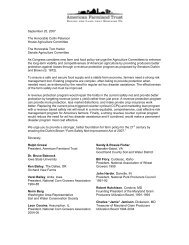
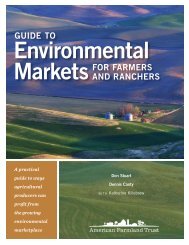
![Farmland by the Numbers [PDF] - American Farmland Trust](https://img.yumpu.com/31549391/1/190x245/farmland-by-the-numbers-pdf-american-farmland-trust.jpg?quality=85)
